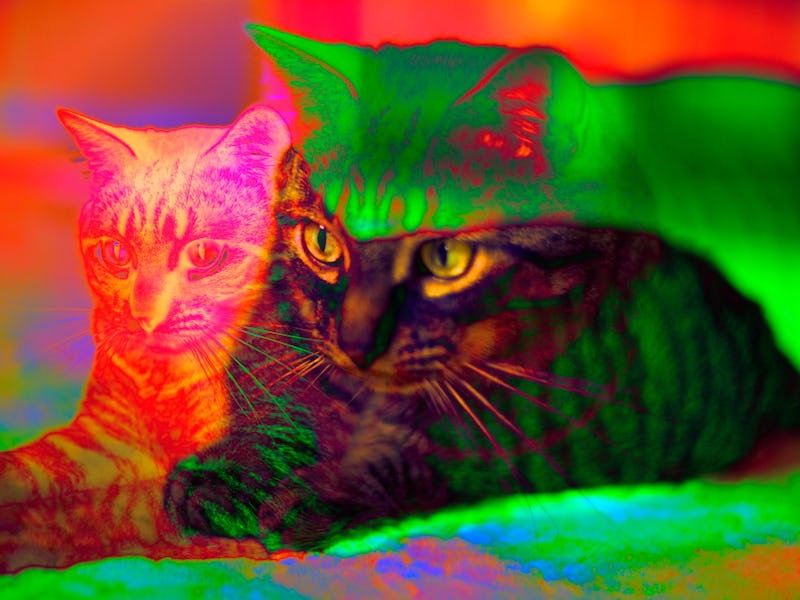Researchers mapped psychedelics in the brain — challenging our understanding of how the drugs work
A new study challenges conventional knowledge about the neuroscience of psychedelics.

“Constellations” of neurotransmitter pathways may contribute to the hallucinogenic experiences induced by drugs like psilocybin and LSD, a new study finds.
A team of researchers from Canada and the United States used natural language processing — where a computer interprets human speech — to search for patterns in a database of almost 7,000 real-world accounts of hallucinogenic experiences induced by roughly 27 different drugs.
They mapped the affinity of each hallucinogenic drug to various neurotransmitter receptors in the brain. Once they identified those receptors, they mapped where in the brain they were most active. The results, published this week in Science Advances challenge our existing understanding of the mechanisms by which hallucinogenic drugs produce their profound effects.
This work may help us understand the nature of human consciousness, says Danilo Bzdok, a medical doctor and computer scientist at McGill University in Canada, and one of the researchers on the study.
“This is where psychedelics are most interesting to [my lab] because it's a mechanistically defined window into human consciousness,” Bzdok tells Inverse. “Because these drugs go into the brain and bind to these receptors and lead to these conscious awareness changes...that is a wide authentic and mechanistically informative window into the brain mechanisms behind subjective awareness.”
The background — Throughout history, humans have turned to various substances to alter their consciousness. From pre-Columbian societies using peyote to the current renewed scientific interest in exploring psilocybin, LSD, and MDMA as treatments for certain mental health conditions, changing one’s consciousness is something humans have found value in for thousands of years.
Yet the scientific community is only beginning to fully explore how hallucinogenic drugs function in the brain and facilitate these shifts in consciousness. We know that many of these hallucinogenic drugs primarily affect a specific subtype of serotonin receptors called 5-HT2A, but how they affect other receptors is less well understood.
That’s what interested Bzdok and his colleagues. “The moment we noticed that everybody's obsessed with serotonin, that spurs the contrarian spirit...we wanted to show that it’s not just serotonin.”
What they did— The researchers used natural language processing tools to search for patterns in the real world, subjective accounts of 6,850 hallucinogenic drug experiences.
“Imagine you have two huge Excel spreadsheets,” Bzdok says, “On the first, you count the occurrence of 14,000 different words, which are all from the testimonies themselves, we did not pick anything about these words.” These words included things like “happy” “color” and moving.” This helped them develop “archetypes” of drug-induced consciousness shifts.
The leading factor underlying hallucinogenic experiences is compatible with the phenomenon of ego dissolution. The statistically strongest pattern of how binding affinities of neurotransmitter receptors were cross-linked with usages of >14,000 words in thousands of real-world hallucinogenic sessions is shown.
On the other sheet, he continues “You have affinities to the 40 neurotransmitter receptors. So that's the starting point, you have two extra sheets, 7000 rows, and on one, you have your words and on the other, you have receptor affinity.”
This allowed the researchers to view the drugs through the lens of the receptors and “really be able to distill what sets of receptors are closely linked to which sets of conscious awareness changes,” he says.
“That’s how we can map out the semantic structure. We can deep dive and zoom in on the semantic elements that are driving these experiences,” he says.
What they found— They found that many common hallucinogenic experiences such as “ego dissolution” didn't come about from activity in 5-HT2A receptors only, but were due to activity in other receptors, too.
The study also found drugs and brain receptors that work in concert to produce visual and auditory experiences, physical experiences (including some of the unpleasant side effects like nausea and vomiting), and the passage of time. Interestingly, it found effects we would typically expect to be associated with areas of the brain responsible for vision like hallucinations might actually be linked to other areas of the brain.
What’s next— Psychedelic drugs have been shown to produce dramatic shifts in consciousness and alleviate stubborn conditions like PTSD and treatment-resistant depression. But to fully harness the treatment potential of these drugs, it would be useful to understand how they work on the most granular neurobiological level. This study provides a new understanding of not only which receptors in the brain are affected by various drugs, but also how the activation of those receptors produces specific experiences and feelings.
In a commentary published in Science Advances, psychiatrists Daniel S. Barron and Richard A. Friedman, who were not involved in the study, reflect on its significance. They write:
Ballentine et al. provide the foundation to quantitatively link drug-induced changes in consciousness to the location in the brain where these changes take place: In essence, they allow us to interpret changes in behavior based on the specific physiologic action of each drug...this method could help us understand how a given molecular tool might improve or even fix a clinically relevant behavioral problem.
The success of psychedelics in treating certain mental health conditions has challenged and expanded our understanding of these conditions. A better understanding of how these drugs work will be equally vital to providing the best treatment possible. Bzdok and his colleagues appear to have developed a novel way to do exactly that.